
The type of worm that infects the internal organs of the human body is called a worm (worm). According to statistics, about 30% of the population today is susceptible to helminthiasis. Worm poisoning can infect any part of the body. This is not only dangerous for diseases that may cause worms. Their presence in the body can be fatal.
So far, helminthiasis can be completely cured not only through medicine but also through folk remedies. Each type has its own treatment method. Therefore, it is necessary to understand and understand the types of worms and the symptoms of parasitic infections in order to take timely measures.
Classification of helminthiasis
Parasitic worms are divided into two categories: intestinal worms and tissue worms.
The first species lives directly in the intestine. This group includes:
- Worms and pinworms;
- Hookworm and lamberian;
- Whipworm and dwarf tapeworm;
- Cattle tapeworm and wide tapeworm;
- Pork tapeworm.
Tissue worms can inhabit any organ of the human body and can parasitize for many years. These include:
- Cysticercus and trematodes;
- Trichinella and liver fluke
- Echinococcus and pneumococcus.
worm
They are the most common and tricky type of worm that lives in the small intestine of adults or children. This worm infection is called as worm disease.
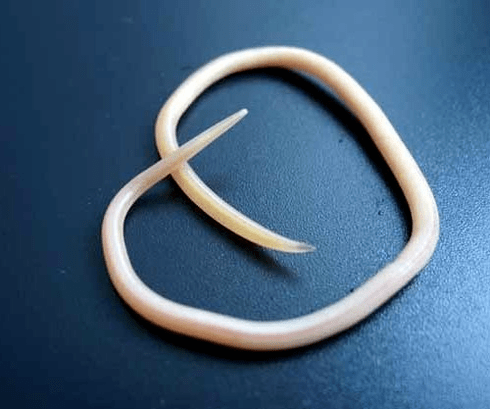
On the first day of the invasion, a person began to feel discomfort, nervousness, fever, shortness of breath, cough and chest pain. The fact that worms initially affect the respiratory system justifies this symptom.
Drinking unverified raw water, unprocessed fresh fruits and vegetables can cause infection. In summer, the risk of asparagus disease will increase.
worm
Small worms placed in the intestine can cause a disease called intestinal disease. Worms lay their eggs in the anal area. The laid eggs become larvae and can only re-enter the body through the mouth.
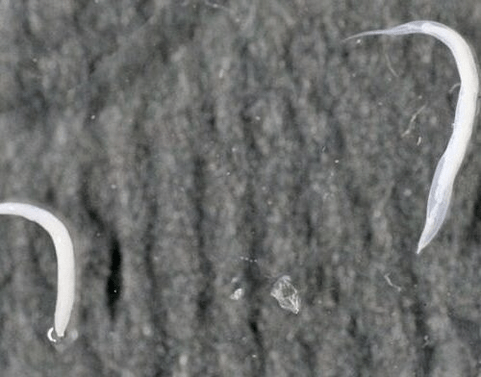
Because the dirty hands of a person suffering from intestinal helminthiasis come into contact with the food he eats, re-infection will occur. Symptoms of infection may include itching and irritability around the anus.
important! This disease is carried by humans.
hookworm
Hookworm infections occur through damaged skin in contact with the ground, and the larvae of these types of worms live on the ground.
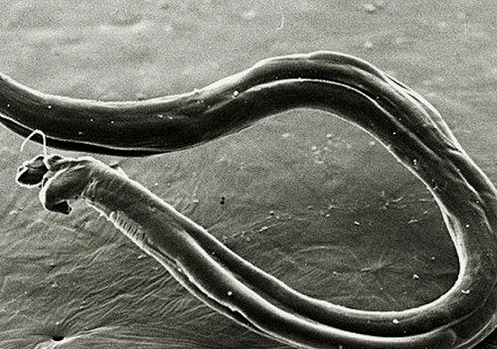
Hookworms follow the same path as roundworms before entering the intestines.
Symptoms include coughing, pain in the lower abdomen, nausea, and stool disturbances. This kind of helminthiasis can cause anemia.
Giardia
Giardiasis develops in people who are used to biting nails and other objects (pencils, pens). Drinking low-quality water, unwashed products, touching dirty clothes (possibly larvae), and spreaders of the disease may also cause infection.
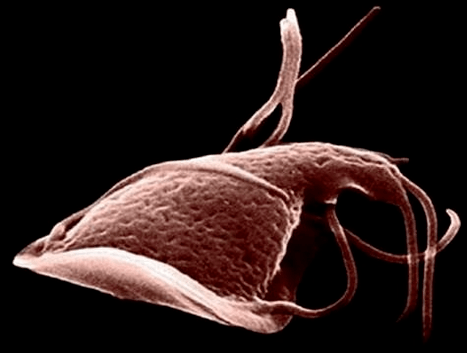
Symptoms of infection may include loose stools and lower abdominal pain.
Vlasoglava
Hairy cephalosporosis occurs during infection with flagella larvae. They enter the room with unprocessed fruits and vegetables. Dirty hands and water are also vectors.
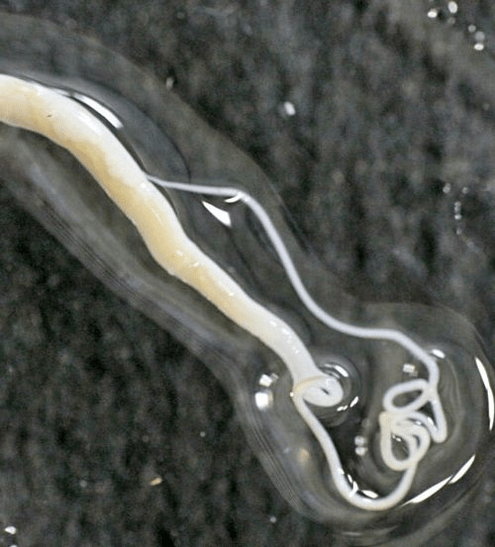
The invasion is accompanied by acute abdominal pain, diarrhea and decreased appetite. The signs of infection are usually similar to appendicitis.
Dwarf tapeworm
Worm infection not only occurs through dirty hands and unwashed food, but insects can also act as carriers.
Dwarf tapeworms can affect the intestines and liver, causing inflammation and poisoning.
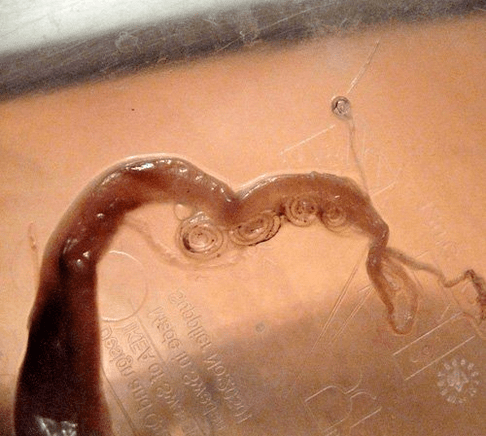
Hyperplasia of blood membrane may be accompanied by malnutrition, loss of appetite, thirst, fatigue and increased nervousness.
Cow tapeworm
One of the most dangerous worms that parasitic in the large intestine.
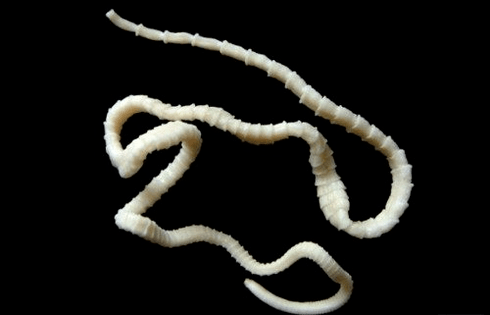
An adult worm can reach several meters in length. The individual takes all the nutrients from the body and produces severe intoxication.
The symptoms of invasion are:
- Diarrhea and abdominal pain;
- Vomiting and nausea;
- Restless sleep;
- dizzy.
When eating under-processed beef contaminated with cattle tapeworm larvae, there is a risk of tenosynovosis.
Wide ribbon
The cause of diploidosis is the consumption of poorly processed fish products and caviar.
The worm that causes this disease is one of the largest and can reach ten meters.
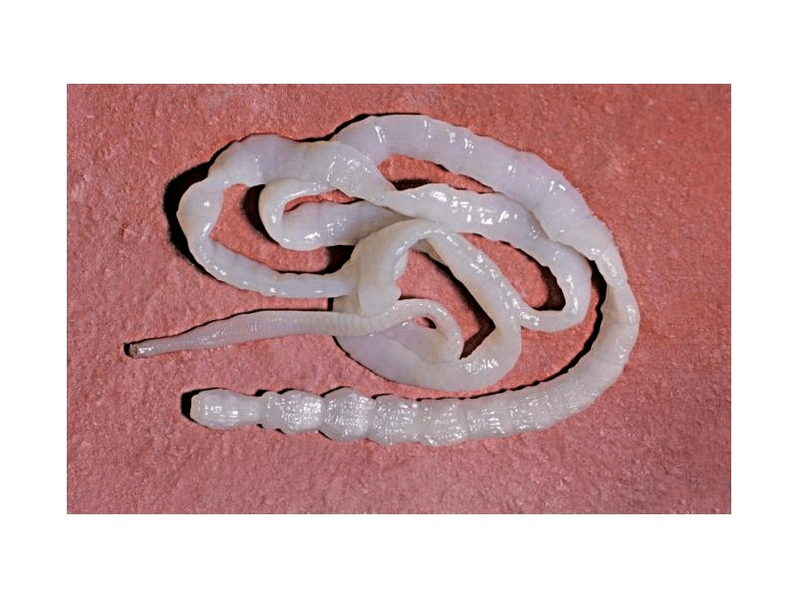
The symptoms of infection are severe pain and anemia in the lower abdomen.
Pork tapeworm
Infection with this worm is extremely dangerous to humans. Eating uncooked pork can cause Finns to enter the body and reach adulthood.
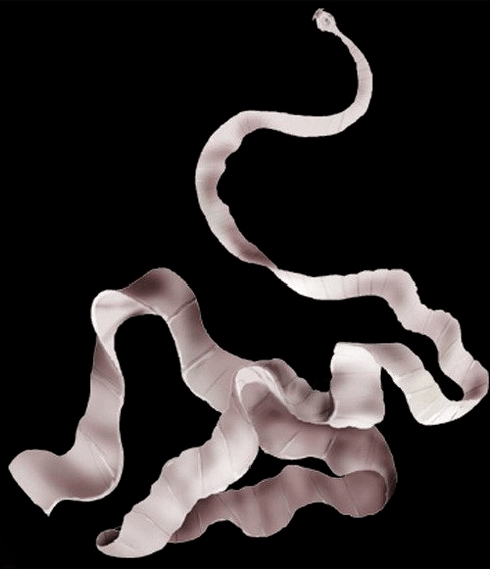
The so-called segments are regularly separated from the body of the pork tapeworm, and they can leave the body on their own through the anus or feces and enter the environment. The signs of tenosynovitis are similar to those of bovine tapeworm infection.
Cysticerki
It is a tissue worm, a product of pork tapeworm segments. Fragments containing tape worm eggs enter the external environment and can re-enter the human body through external environmental objects and cause the development of cysticercosis.
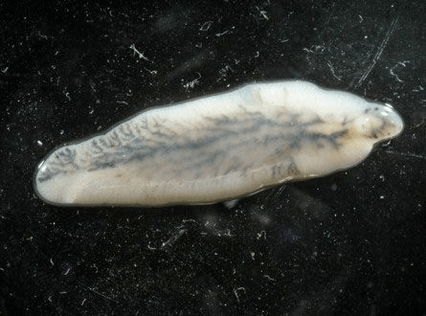
The parasites can stay in the muscles, heart muscles and even the brain.
important! They have a squeezing effect on organs and cause inflammation.
Liver fluke
Fluke liver fluke disease is caused by smoking liver fluke larvae and infected fish into the human body.

There are signs of aspirin dilation of the trachea:
- nausea;
- diarrhea;
- Body aches;
- Occurrence of allergies.
More severe symptoms are chronic. This type of parasite is very dangerous for the development of liver cancer.
Echinococcus
Worms usually settle in the liver or lungs. Echinococcus can cause the formation of cysts and the appearance of tumors in the affected organs. The infection can be fatal.
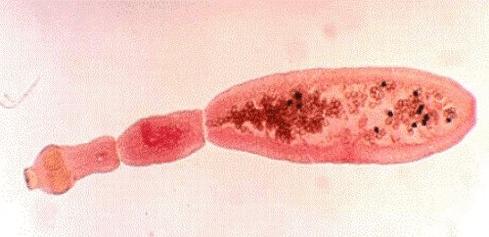
The larvae are transmitted to humans through contact with diseased animals.
Trichinella
Trichinosis mainly affects people who eat poorly processed wild animal meat. Pigs can also be carriers of Trichinella spiralis.
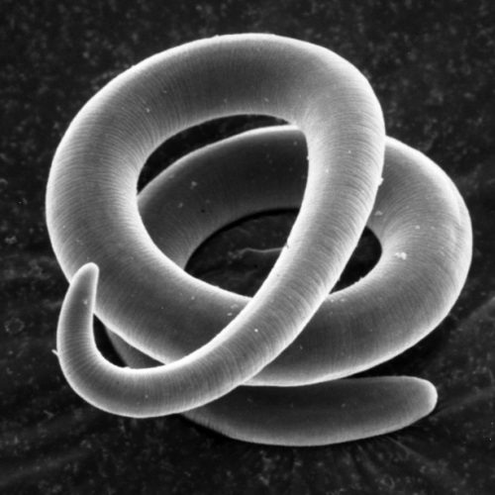
The habitat of an adult is various types of muscles (breathing, face, etc. ).
In the early stages, there will be nausea and loose stools. The subsequent symptoms of the invasion are fever, swelling, skin rash, and muscle pain. Infection with this parasite without prompt treatment can be fatal.

How humans are infected with worms
- Biological helminthiasis (an animal infection).
- Infectious helminthiasis (spread from person to person).
- Helminthiasis (a disease caused by a parasite that performs one of its life cycles on the earth).
Factors affecting the performance of helminthiasis
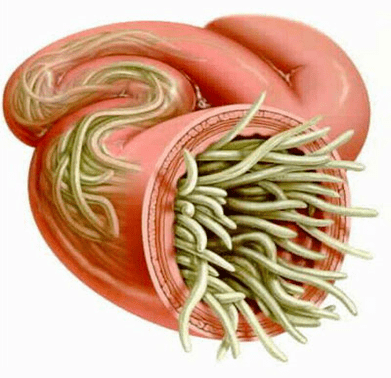
The way the parasite enters the body;
- The degree of adaptation of the worm to the human body;
- Population density (number) of individual parasites;
- The habitat of worms (tissue parasites live in the thickness of soft tissue, while intracavitary parasites live in the gaps of hollow organs). Some worms at different stages have both lumen and tissue forms. Generally, the larvae and developmental stages of worms cause more obvious pathological changes.
In the absence of re-infection, the number of adult parasites in the human body will not increase. This function can distinguish worm invasion from diseases caused by bacteria, viruses, fungi and protozoa.
Human worms: symptoms
Helminthiasis is a disease characterized by two stages of the process (acute, from two weeks to two months) and chronic (from months to years).
Symptoms of Acute Helminthiasis
The initial signs of the disease may appear at different times (the most common are 2-3 weeks later, ass worm disease-2-3 days later, and the incubation period of filariasis can last for 6-18 months).
In the acute phase of a parasite invasion, the most typical symptom is an allergic reaction (antibodies against the antigens of the migrating parasite larvae). Usually in people infected with worms, a pruritic rash appears on the skin, which is easy to recur, local lymph nodes increase, systemic or local edema, and muscle and joint pain may occur. In addition, the migrating parasite larvae can also cause chest pain, coughing, choking episodes, bowel disturbances, nausea and vomiting.
Signs of chronic helminthiasis
The symptoms of the chronic phase directly depend on which organ the parasite "inhabits" in, and their size and number also play an important role.
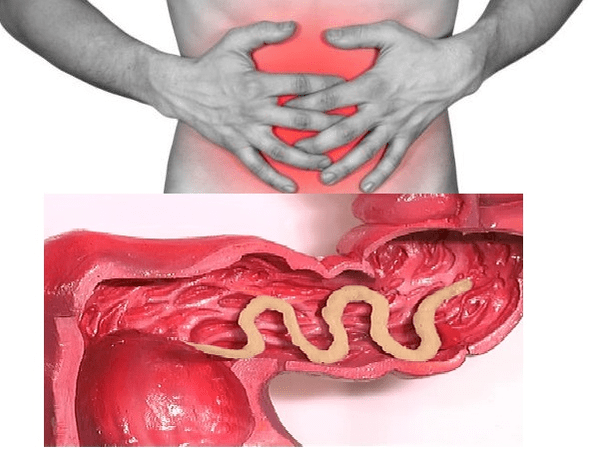
Therefore, when parasitic in the intestine of a single person, the disease may be asymptomatic (except when the infected parasite is very large). The characteristic symptom of the chronic phase of intestinal helminthiasis is indigestion. In children, neurasthenia and pain syndrome are more pronounced. With the massive invasion of roundworms, it may cause intestinal obstruction, obstructive jaundice and pancreatitis.
In people with helminthiasis, the risk of malignant tumors is significantly increased due to the weakening of the immune system and the enhancement of the cell division process (the result of the constant restoration of tissues destroyed by the parasite).
Types of worms that live in the human body
There are two types of worms that cause human helminthiasis: round worms (nematodes) and flat worms (band and worms).
Roundworm
worm
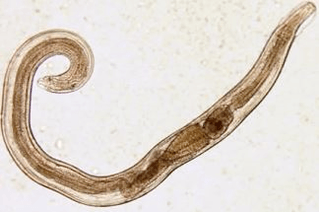
The parasites that cause small intestinal worms are small, off-white worms (maximum 10 mm). The infection occurs in the diet (through the mouth). The reason is dirty hands. Parasite eggs can be found on the ground of infected animals’ wool, unwashed vegetables and fruits. At the same time, due to intestinal bia disease, self-infection often occurs (especially in children), which is caused by scratching. The itchy area, then swallow the egg. The worm larvae develop within two weeks of the digestive tract. After becoming an adult, the worm parasitizes the small part of the colon and the lower part of the upper part.
insect
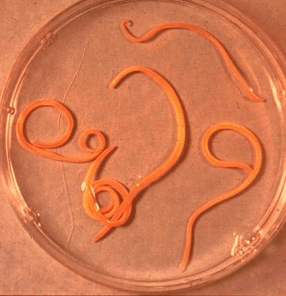
Scarworms are red-yellow, large spindle-shaped parasites that reach 40 cm (female) and 15-25 cm (male) in adulthood. In the absence of suction cups or other fastening devices, the worm can independently move towards the food mass. The eggs laid by female parasites are excreted with feces.
Vlasograf
Vlasoglav (Vlasoglav) is the causative agent of caterpillar disease. It is a white worm that parasitizes in the early stage of the large intestine. The size is 4-5 cm. The parasite feeds on the blood and tissues of the rectal mucosa.
Due to the small number of worms, there is no hairy cephalosporosis. In the severe stage (with a large amount of infiltration), patients experience abdominal pain, severe diarrhea, and sometimes rectal prolapse. This condition is most commonly observed in frail children. The moderate trichomoniasis stage may cause developmental delays in children.
Trichinella

The causative agent of trichinosis is a small round worm with a length of 2-5 mm. Infection can occur when eating poorly roasted meat (pork, bear meat, wild boar). After the larva of the parasite penetrates into the intestine, it will mature in 3-4 days and become a sexually mature individual. The lifespan of the worm is 40 days, after which the parasite dies. By piercing the intestinal wall, the larva enters the bloodstream and is taken to all organs of the human body and settles in the muscles. In this case, the breathing and facial muscles and the flexors of the limbs are most often affected.
In the first few days after the invasion, the patient complained of abdominal pain. Then, about 2 weeks later, the body temperature rose to 39-40 degrees Celsius, an itchy rash appeared on the skin, muscle pain appeared, and facial swelling appeared. During this period, if a large-scale infection occurs, there is a great risk of death. About a month later, the patient recovered. The parasite was wrapped in a spiral and then died within two years.
Hookworm and nekator
The biological characteristics of these two parasites and the diseases they cause are similar. In this regard, it is customary to combine them with a common name (hookworm). The length of the worm reaches 10-15 mm and parasitizes in 12 p. intestinal. It should be noted that this is one of the most common parasites, but at the same time, this parasite is rarely found. Worm larvae enter the human body through the skin when they come into contact with contaminated soil. In addition, they enter the bloodstream like round worms, migrate to the lungs, and then enter the digestive tract through the bronchus together with expectorants. The vascular anastomosis is parasitic in the intestine, making itself attached to the intestinal wall. Therefore, the most typical symptoms of this helminthiasis are iron deficiency anemia and changes in the ratio of protein components (protein abnormalities).
Flatworm
Wide ribbon
This is one of the largest worms, up to 10 to 20 meters. The disease caused by this parasite is called bilobal flagellosis. The development cycle of worms begins with freshwater fish or crustaceans. The larva enters the human body along with the eggs or infected fish fillets and is the ultimate owner of the tapeworm. After reaching the small intestine, the parasite attaches to the wall of the small intestine and grows into a mature individual within 20-25 days.
Biloba flagellosis occurs in the context of gastrointestinal diseases and B12 deficiency anemia.
Liver fluke
The parasite that causes bronchiolitis is a flat worm that can reach 7-20 mm in length. Eating contaminated fish that has not been sufficiently heat-treated can cause human infections. Liver fluke larvae from the small intestine penetrate the bile duct and gallbladder and are fixed there with two suction cups.
In the acute phase of helminthiasis, the patient has upper abdomen soreness, elevated body temperature, nausea, muscle pain, diarrhea, and a skin rash. The chronic course of aspirin is manifested as hepatitis, bile duct inflammation, cholecystitis, digestive tract disease, neurological disease, weakness and fatigue. Parasites can cause irreversible changes, and even if they are expelled, patients will not experience chronic inflammatory processes and dysfunction.
Cow and pork tapeworm
The structure of these parasites is almost the same, and the length is 5-6 meters. As a result of eating meat from cattle or pork infected by Finns (one of the intermediate forms of helminthiasis), whipworm and whipworm infections have occurred. Viable Finns appear in the form of whitish bubbles, reaching a size of 0. 5 cm, attaching to the wall of the human small intestine, and becoming an adult within 3 months. Banded parasites containing more than 2, 000 fragments are growing.
Echinococcus
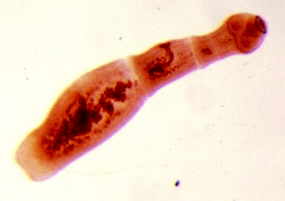
For this parasite, a person is the intermediate host. Worms parasitize the human body in the form of Finns. The ultimate owner of Echinococcus ococcus is wolf, dog or cat. Infection can occur in the diet through contact with animals and environmental objects inoculated with Echinococcus eggs. After entering the intestine, cancer balls (six hook-shaped larvae) form from their bodies. They enter the bloodstream from the intestines and are transported throughout the body.
Pneumococcus
This parasite is considered a type of echinococcosis and is the cause of one of the most dangerous helminthiasis (pneumococcal disease), and its severity is similar to cirrhosis and liver cancer. Infection occurs when the cancer ball (egg with mature larvae) penetrates the intestine. Duodenal cyst is a very aggressive structure, which grows continuously due to the increase of bubbles, and has the ability to grow to the liver like cancer metastasis. Necrotic changes caused by vascular dysfunction occur in nearby tissues. Alveolar cocci spread to nearby structures, forming fibrous knots with multiple protruding bubbles. This situation may last for several years and therefore requires mandatory surgical intervention.
Diagnosis of helminthiasis
The diagnosis of worm invasion includes the following activities:
- Collect recall records carefully, which helps to find out possible causes of infection;
- Laboratory examination of stool, blood, intestinal contents 12p, rectal and perianal mucus, muscle tissue, lung sputum, and bile. Analysis may reveal eggs, fragments or fragments of parasites. At the same time, the increase in the content of eosinophils in the blood is also a signal for the presence of helminthiasis.
- When diagnosing diseases caused by larval stages or tissue parasites, serological tests (ELISA, RSK, indirect agglutination, immunofluorescence analysis, etc. ) will be performed.
- In order to identify worms that affect liver tissue, ultrasound, CT, and endoscopy are recommended.
Human worms: treatment
In the acute phase of parasitic infection, patients need detoxification and desensitization treatment. In severe cases of disease (liver flukes, trichinosis), glucocorticoids are used according to medical indications.
Taking into account the nature of the pathogen, as a special treatment medicine, special anthelmintics are required.
At the same time, patients are advised to take antihistamines and intestinal absorbers. The final stage of treatment involves the use of probiotics that normalize the intestinal flora.
A special mild diet is also prescribed (food should be easy to digest and low in fat).
During treatment with antihelminthics, patients are required to strictly observe personal hygiene habits (to avoid re-infection). At the same time, for many helminths, all family members and people who keep in regular contact with the infected person must receive treatment.
The underestimation of their danger, coupled with insufficient knowledge of the biology of these organisms and their infection methods, has led to the fact that at least billions of people are now carriers of certain parasites.
Parasites can not only exist in the human body, but can even exist outside the human body.
Prevent parasite infestation
Rule 1:You cannot eat anything from salted, fried or cooked fish. Sushi, salted herring or sashimi can be considered as gourmet dishes. But in essence, it is raw fish, and fish is one of the components of the life cycle of parasitic worms.
How it all happened:First, the larva enters the mollusk, its growth will not exceed a certain limit, then the fish eats the mollusc, the larva enters the digestive tract, stays alive, then grows and reproduces, enters the muscle tissue of the fish, and then the fish is caught by a dolphin, seagull or polar bearEat it. Or restaurant visitors who decide to join the high-end Japanese culture.
In theory, there are safe raw fish. For this reason, it must be frozen immediately after harvesting and thawed before cooking, or it must be specially grown in fish farms without parasites. However, it is usually impossible to check whether a risky dish is actually prepared from it.
The same must be done with meat; don’t try raw minced meat and freshly marinated bacon.
In addition, in order not to be infected by worms, you must wash vegetables and hands before eating. As a component of the natural environment, these parasites in the human body are almost everywhere.
Any contact of food or hands with the ground, dust and plants may leave their tiny eggs on the food. If they enter the intestines, the worms will hatch from the eggs, which will not be easy to remove.
Some parasites attack people who walk or relax in nature, such as:
- Plasmodium, contained in the saliva of Anopheles mosquitoes,
- The pathogen of encephalitis contained in lice saliva,
- ad and wolf fly.
Their prevention includes the use of various mosquito repellents during wild hikes and maximum protection of the open areas of the body (mosquito nets, mosquito nets, special gels).
But if prevention does not help, what should you do? Since this attack has been known for a long time, folk methods have been used for treatment for a long time.
All in all, it can be noted that following simple hygiene and sanitation rules, extermination of flies and cockroaches can significantly reduce the risk of parasitic infections, which can lead to serious consequences.

























